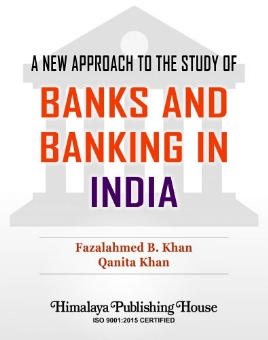Banking system is called the lifeblood of an economy. Banking as a discipline has evolved over the centuries the world over, forming its theories and principles, methodologies, rules of business and developing its practices of high technology, soundness and prudence. Origin of banking has its genesis in India in the 18th century, when seven banks were established between 1720 and 1788. The 19th century saw addition of more banks and entry of a few foreign banks. For long (till 1960s), banks had a vulnerable existence, as failure of banks was not uncommon. Now, they are on sound footings. Establishment of the Reserve Bank of India in 1934, as the central bank of the country was a milestone. The enactment of the Banking Regulation Act, 1949 made for orderly development of banking. Nationalisation of major banks in 1969 and 1980 was a watershed development which brought about a transformative phase making for meeting the credit needs of the varied sectors of the economy, expanding outreach of banks far and wide and aid financial inclusion. The public sector banks played their role remarkably. The recommendations of the Narasimham Committee on Financial System (1991) and on the Banking Sector Reforms (1998) resulted into wide reforms in the banking sector in India. New private banks (from 1994 onwards) have brought a spirit of competition and vibrancy. Banking technology has developed remarkably well. Co-operative banks have their vast network. From 2010 to 2020, India witnessed a revolution of payment and settlement systems with digital technologies. Setting up of Development Finance Institutions differentiated banks in the form of Local Area Banks, Small Finance Banks and Payments Banks have been valued additions. Two brilliant facts and figures showcasing the growth of banks in India are as under:
(a) In 1952, there were just 4061 branches of scheduled commercial banks in India, which rose to 1,50,248 branches by the end of 2020-21 with 2,38,558 ATMs and 11,90,425 banking outlets through Banking Correspondents.
(b) In 1952, the total deposits and credits of all scheduled commercial banks were Rs. 882 crore and Rs. 547 crore respectively. By the end of FY 2020, they rose to (Deposits) Rs. 1,55,90,600 crore and (Credit) Rs. 1,08,20,208 crore respectively.
All these make for an amazing story of the progress of banks and banking in India. It can be aptly said that banking in India is now new age banking. This book is an attempt to capture this glorious story – the origin and development of banking in India with all its vivacity, its challenges and achievements, its issues as well as its successes. It elaborates this narrative in a simple and lucid style, supported by statistics from authentic sources; mostly from the vast database that the Reserve Bank of India has kept on placing in the public domain.
Contents –
1. Indian Financial System
2. Money
3. Banks and Banking
4. Banks and Banking in India
5. Ratios/Terms Used in Banking in India
6. Origin and Development of Banks in India – Part I (Inception to 1947)
7. Origin and Development of Banking in India – Part II (1947 to 1968)
8. Origin and Development of Banking in India – Part III (Nationalisation of Major Commercial Banks in 1969 and Other Developments till 1990)
9. Origin and Development of Banking in India – Part IV (1990 Onwards)
10. Banking Legislation in India
11. Government Control over Banks
12. Reserve Bank of India
13. Development Finance Institutions
14. Nationalisation of Major Commercial Banks in 1969 and 1980
15. Public Sector Banks – Heritage List (Position as in 2016-17)
16. Recapitalisation and Revamping Public Sector Banks and Reforms
17. Merger and Amalgamation of Public Sector Banks
18. Public Sector Banks (Their Performance during 2020-21)
19. Merger and Amalgamation of Private Banks
20. Old Private Sector Banks
21. New Private Sector Banks
22. Public Sector Banks and Private Sector Banks – A Comparison and Competition
23. Foreign Banks
24. Cooperative Banks in India
25. Regional Rural Banks
26. Local Area Banks
27. Small Finance Banks
28. Payments Banks
29. Universal Banks
30. Support/Allied Institutions of Banking
31. Bank Deposit Insurance in India
32. Payment and Settlement Systems
33. Lending Rate, Bank Rate, Repo Rate and Reverse Repo Rate
34. Customer Relations by Banks
35. Basel Norms – Basel I, II and III
36. Banking Technology, FinTech
37. Financial Inclusion through Banks, Jan-dhan Yojana, Banking Correspondents, etc.
38. Cheque Clearance
39. Frauds in Banks and Banking
40. Non-performing Assets
41. Some Prominent Features and Operational Matters of Banking
42. International Forums on Finance and Banking
43. Ten Best Global Banking Practices







